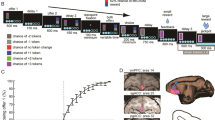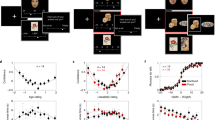Abstract
When choosing between two options, correlates of their value are represented in neural activity throughout the brain. Whether these representations reflect activity that is fundamental to the computational process of value comparison, as opposed to other computations covarying with value, is unknown. We investigated activity in a biophysically plausible network model that transforms inputs relating to value into categorical choices. A set of characteristic time-varying signals emerged that reflect value comparison. We tested these model predictions using magnetoencephalography data recorded from human subjects performing value-guided decisions. Parietal and prefrontal signals matched closely with model predictions. These results provide a mechanistic explanation of neural signals recorded during value-guided choice and a means of distinguishing computational roles of different cortical regions whose activity covaries with value.
This is a preview of subscription content, access via your institution
Access options
Subscribe to this journal
Receive 12 print issues and online access
$209.00 per year
only $17.42 per issue
Buy this article
- Purchase on Springer Link
- Instant access to full article PDF
Prices may be subject to local taxes which are calculated during checkout





Similar content being viewed by others
References
von Neumann, J. & Morgenstern, O. Theory of Games and Economic Behavior (Princeton University Press, 1944).
Dickinson, A. & Balleine, B. Motivational control of goal-directed action. Learn. Behav. 22, 1–18 (1994).
Stephens, D.W. & Krebs, J.R. Foraging Theory (Princeton University Press, 1986).
Sutton, R. & Barto, A. Reinforcement Learning: an Introduction (MIT Press, 1998).
Rushworth, M.F. & Behrens, T.E.J. Choice, uncertainty and value in prefrontal and cingulate cortex. Nat. Neurosci. 11, 389–397 (2008).
Kable, J.W. & Glimcher, P.W. The neurobiology of decision: consensus and controversy. Neuron 63, 733–745 (2009).
Padoa-Schioppa, C. Neurobiology of economic choice: a good-based model. Annu. Rev. Neurosci. 34, 333–359 (2011).
Rangel, A., Camerer, C.F. & Montague, P.R. A framework for studying the neurobiology of value-based decision making. Nat. Rev. Neurosci. 9, 545–556 (2008).
Platt, M.L. & Glimcher, P.W. Neural correlates of decision variables in parietal cortex. Nature 400, 233–238 (1999).
Sugrue, L.P., Corrado, G.S. & Newsome, W.T. Matching behavior and the representation of value in the parietal cortex. Science 304, 1782–1787 (2004).
Tom, S.M., Fox, C.R., Trepel, C. & Poldrack, R.A. The neural basis of loss aversion in decision-making under risk. Science 315, 515–518 (2007).
Plassmann, H., O'Doherty, J.P. & Rangel, A. Orbitofrontal cortex encodes willingness to pay in everyday economic transactions. J. Neurosci. 27, 9984–9988 (2007).
Knutson, B., Taylor, J., Kaufman, M., Peterson, R. & Glover, G. Distributed neural representation of expected value. J. Neurosci. 25, 4806–4812 (2005).
Boorman, E.D., Behrens, T.E.J., Woolrich, M.W. & Rushworth, M.S.F. How green is the grass on the other side? Frontopolar cortex and the evidence in favor of alternative courses of action. Neuron 62, 733–743 (2009).
Blair, K. et al. Choosing the lesser of two evils, the better of two goods: specifying the roles of ventromedial prefrontal cortex and dorsal anterior cingulate in object choice. J. Neurosci. 26, 11379–11386 (2006).
Kable, J.W. & Glimcher, P.W. The neural correlates of subjective value during intertemporal choice. Nat. Neurosci. 10, 1625–1633 (2007).
Cai, X., Kim, S. & Lee, D. Heterogeneous coding of temporally discounted values in the dorsal and ventral striatum during intertemporal choice. Neuron 69, 170–182 (2011).
Kennerley, S.W., Dahmubed, A.F., Lara, A.H. & Wallis, J.D. Neurons in the frontal lobe encode the value of multiple decision variables. J. Cogn. Neurosci. 21, 1162–1178 (2009).
Usher, M. & McClelland, J.L. The time course of perceptual choice: the leaky, competing accumulator model. Psychol. Rev. 108, 550–592 (2001).
Wang, X.J. Probabilistic decision making by slow reverberation in cortical circuits. Neuron 36, 955–968 (2002).
Shadlen, M.N. & Newsome, W.T. Neural basis of a perceptual decision in the parietal cortex (area LIP) of the rhesus monkey. J. Neurophysiol. 86, 1916–1936 (2001).
Soltani, A. & Wang, X.J. A biophysically based neural model of matching law behavior: melioration by stochastic synapses. J. Neurosci. 26, 3731–3744 (2006).
Wong, K.F., Huk, A.C., Shadlen, M.N. & Wang, X.J. Neural circuit dynamics underlying accumulation of time-varying evidence during perceptual decision making. Front. Comput. Neurosci. 1, 6 (2007).
Wong, K.F. & Wang, X.J. A recurrent network mechanism of time integration in perceptual decisions. J. Neurosci. 26, 1314–1328 (2006).
Hämäläinen, M.S., Hari, R., Ilmoniemi, R.J. & Knuutila, J. Magnetoencephalography: theory, instrumentation and applications to noninvasive studies of the human brain. Rev. Mod. Phys. 65, 413–497 (1993).
Tallon-Baudry, C., Bertrand, O., Delpuech, C. & Permier, J. Oscillatory gamma-band (30–70 Hz) activity induced by a visual search task in humans. J. Neurosci. 17, 722–734 (1997).
Tversky, A. & Kahneman, D. Advances in prospect theory: cumulative representation of uncertainty. J. Risk Uncertain. 5, 297–323 (1992).
Van Veen, B.D., van Drongelen, W., Yuchtman, M. & Suzuki, A. Localization of brain electrical activity via linearly constrained minimum variance spatial filtering. IEEE Trans. Biomed. Eng. 44, 867–880 (1997).
Johnson, P.B., Ferraina, S., Bianchi, L. & Caminiti, R. Cortical networks for visual reaching: physiological and anatomical organization of frontal and parietal lobe arm regions. Cereb. Cortex 6, 102–119 (1996).
Gershman, S.J., Pesaran, B. & Daw, N.D. Human reinforcement learning subdivides structured action spaces by learning effector-specific values. J. Neurosci. 29, 13524–13531 (2009).
Serences, J.T. Value-based modulations in human visual cortex. Neuron 60, 1169–1181 (2008).
Noonan, M.P. et al. Separate value comparison and learning mechanisms in macaque medial and lateral orbitofrontal cortex. Proc. Natl. Acad. Sci. U S A 107, 20547–20552 (2010).
Hillebrand, A. & Barnes, G.R. A quantitative assessment of the sensitivity of whole-head MEG to activity in the adult human cortex. Neuroimage 16, 638–650 (2002).
Marinkovic, K., Cox, B., Reid, K. & Halgren, E. Head position in the MEG helmet affects the sensitivity to anterior sources. Neurol. Clin. Neurophysiol. 2004, 30 (2004).
Sigman, M. & Dehaene, S. Parsing a cognitive task: a characterization of the mind′s bottleneck. PLoS Biol. 3, e37 (2005).
Milosavljevic, M., Malmaud, J., Huth, A., Koch, C. & Rangel, A. The drift diffusion model can account for the accuracy and reaction time of value-based choices under high and low time pressure. Judgm. Decis. Mak. 5, 437–449 (2010).
deCharms, R.C. & Zador, A. Neural representation and the cortical code. Annu. Rev. Neurosci. 23, 613–647 (2000).
Scheperjans, F. et al. Observer-independent cytoarchitectonic mapping of the human superior parietal cortex. Cereb. Cortex 18, 846–867 (2008).
Mars, R.B. et al. Diffusion weighted imaging tractography-based parcellation of the human parietal cortex and comparison with human and macaque resting state functional connectivity. J. Neurosci. 31, 4087–4100 (2011).
Haber, S.N., Kim, K.S., Mailly, P. & Calzavara, R. Reward-related cortical inputs define a large striatal region in primates that interface with associative cortical connections, providing a substrate for incentive-based learning. J. Neurosci. 26, 8368–8376 (2006).
Kim, S. & Lee, D. Prefrontal cortex and impulsive decision making. Biol. Psychiatry 69, 1140–1146 (2011).
Fellows, L.K. Deciding how to decide: ventromedial frontal lobe damage affects information acquisition in multi-attribute decision making. Brain 129, 944–952 (2006).
Basten, U., Biele, G., Heekeren, H.R. & Fiebach, C.J. How the brain integrates costs and benefits during decision making. Proc. Natl. Acad. Sci. USA 107, 21767–21772 (2010).
Rolls, E.T., Grabenhorst, F. & Deco, G. Choice, difficulty, and confidence in the brain. Neuroimage 53, 694–706 (2010).
Kiebel, S.J., Garrido, M.I., Moran, R., Chen, C.C. & Friston, K.J. Dynamic causal modeling for EEG and MEG. Hum. Brain Mapp. 30, 1866–1876 (2009).
Compte, A., Brunel, N., Goldman-Rakic, P.S. & Wang, X.J. Synaptic mechanisms and network dynamics underlying spatial working memory in a cortical network model. Cereb. Cortex 10, 910–923 (2000).
Meltzer, J.A. et al. Effects of working memory load on oscillatory power in human intracranial EEG. Cereb Cortex 18, 1843–1855 (2008).
Muthukumaraswamy, S.D., Edden, R.A., Jones, D.K., Swettenham, J.B. & Singh, K.D. Resting GABA concentration predicts peak gamma frequency and fMRI amplitude in response to visual stimulation in humans. Proc. Natl. Acad. Sci. USA 106, 8356–8361 (2009).
Hsu, M., Krajbich, I., Zhao, C. & Camerer, C.F. Neural response to reward anticipation under risk is nonlinear in probabilities. J. Neurosci. 29, 2231–2237 (2009).
Berg, P. & Scherg, M. A multiple source approach to the correction of eye artifacts. Electroencephalogr. Clin. Neurophysiol. 90, 229–241 (1994).
Acknowledgements
We thank V. Litvak and G. Barnes for many helpful discussions, C. Stagg and K. Friston for comments on the manuscript, T. Nichols for assistance implementing four-dimensional cluster-based permutation testing, and S. Braeutigam and A. Rao for help with data collection. This work was supported by the Wellcome Trust (L.T.H., N.K., M.W.W. and T.E.J.B., grant reference numbers WT088312 and WT080540), the Consortium Of Neuroimagers for Non-invasive Exploration of Brain Connectivity and Tracts (CONNECT; L.T.H. and T.E.J.B.), the UK Medical Research Council (M.F.S.R.) and the UK Engineering and Physical Sciences Research Council (M.W.W.). The project CONNECT acknowledges the financial support of the Future and Emerging Technologies (FET) program in the Seventh Framework Program for Research of the European Commission, under FET-Open grant number 238292.
Author information
Authors and Affiliations
Contributions
L.T.H., T.E.J.B. and M.F.S.R. designed experiment. L.T.H. and N.K. collected data. A.S. and L.T.H. built models and analyzed model predictions. M.W.W. wrote code for source reconstruction. L.T.H., T.E.J.B., N.K. and M.W.W. analyzed data. L.T.H., M.F.S.R. and T.E.J.B. wrote the paper. All of the authors discussed the results and commented on the manuscript.
Corresponding authors
Ethics declarations
Competing interests
The authors declare no competing financial interests.
Supplementary information
Supplementary Text and Figures
Supplementary Figures 1–13, Supplementary Tables 1–3 and Supplementary Discussion (PDF 1806 kb)
Supplementary Movie 1
Temporal evolution of stimulus-locked activity (MOV 4476 kb)
Supplementary Movie 2
Temporal evolution of response-locked activity (MOV 5726 kb)
Rights and permissions
About this article
Cite this article
Hunt, L., Kolling, N., Soltani, A. et al. Mechanisms underlying cortical activity during value-guided choice. Nat Neurosci 15, 470–476 (2012). https://doi.org/10.1038/nn.3017
Received:
Accepted:
Published:
Issue Date:
DOI: https://doi.org/10.1038/nn.3017
This article is cited by
-
Orthogonal neural encoding of targets and distractors supports multivariate cognitive control
Nature Human Behaviour (2024)
-
Differential replay of reward and punishment paths predicts approach and avoidance
Nature Neuroscience (2023)
-
Value dynamics affect choice preparation during decision-making
Nature Neuroscience (2023)
-
Advances in modeling learning and decision-making in neuroscience
Neuropsychopharmacology (2022)
-
Taking stock of value in the orbitofrontal cortex
Nature Reviews Neuroscience (2022)



